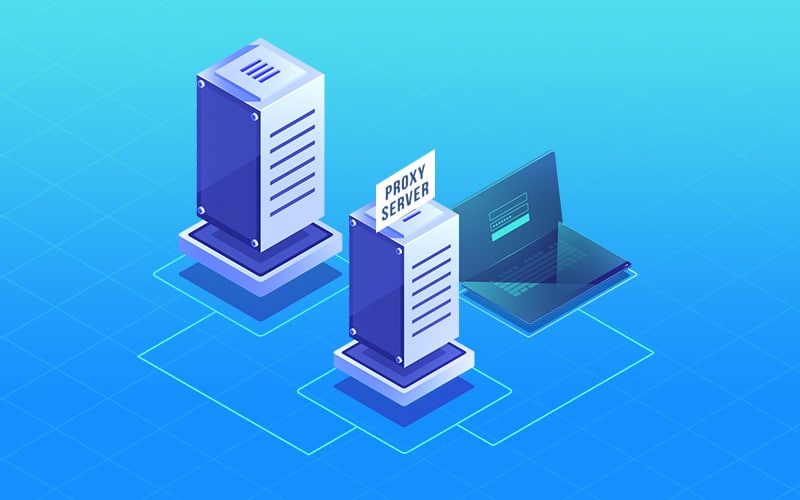A proxy server is a device that acts as an intermediary between your computer and the internet, handling all of your requests for websites, files, or other information. In effect, it hides the fact that you are connecting to the internet from those sites you connect to. Parents have used them to monitor their children’s browsing habits since the 1990s and by those trying to circumvent government censorship since then. Nowadays, they are commonly used by businesses and corporations to protect their networks from outside attacks.
The basic idea of a proxy server is to simulate the Internet connections of other computers on your network. Because encrypted connections are not supported, Internet traffic is routed via the proxy, which will intercept all packets passing through it, decrypt them if necessary, and re-encrypt them with your machine’s public key before sending them to the target. The destination server will only verify that the source address matches its public address. You can click for more info to understand Proxy Servers better.

Functions of Proxy Servers –
Proxy servers can be very useful in troubleshooting IT networks. They allow you to see what is going on that might not otherwise be apparent. For example, if a user thinks that they cannot connect to their Webmail, they can try opening a web browser and using the proxy server to see what is happening. It is typically the first step in troubleshooting site-to-site VPN problems.
Most proxy servers can be used to block sites you do not want employees visiting on company time. It makes sense in an office environment but can be useful even in a home setting. However, you have to remember that blocking sites is not 100% effective when using them on an employee’s computer. Some people can still access blocked sites through different proxy servers found online.
Types of Proxy Servers –
- Home Proxy Server –
A home proxy server is an option for your computer if you want to set up something similar to what your Internet service provider offers. There are free and commercial services that can create a home proxy server. The main function of a home proxy server is to monitor a preconfigured list of websites at a specific URL.
If you think that the site you are visiting is blocked from your ISP, you can try using a home proxy server. For example, if your ISP provides webmail and file storage services, you can set up a home proxy server to use those services. This way, you do not have to go on the Internet through your ISP’s proxy server.
- Caching Proxy Server –
A caching proxy server is a useful way of improving network performance. For example, suppose there is a remote office with a slow connection to the company’s headquarters. The headquarters has a high-speed connection to the Internet, but the remote office can only get a slower connection.
A caching proxy server on the remote site can improve performance by using the headquarters as a download source. Caching proxy servers are useful for helping to improve the load times of websites. If you rarely access a website, you do not have to wait long to download content from its Web server. If you access the same site frequently, it will be served from memory instead of downloading it each time.
- Reverse Proxy Server –
A reverse proxy server is a type of proxy server used to make the client’s request. The client’s request goes to the proxy server, which translates it into HTTP protocol, encrypts it with the IP addresses of the target servers, and sends it to the target servers. The target servers decrypt and read the encrypted information, which they can understand because all requests are largely identical except for their IP address.
Reverse proxy servers are popular in many companies because they shield internal clients. It is one of the primary reasons for using reverse proxy servers, but it can also improve performance. For example, a caching server can be used in reverse proxy mode to serve content from their cache instead of accessing it over the network.
- Application-Level Gateway (ALG) Proxy Servers –
Application-level gateway proxy servers are slightly different from normal proxy servers in that they are not doing any translation. The only task they perform is to intercept requests for your Web server and translate them to HTTP requests. It makes ALG proxy servers more like a firewall than a normal proxy server. However, ALG proxy servers can also add extra functionality such as secure (SSL) traffic redirection.

Proxy Server Installation –
Proxy server installation is a very simple process. First, you have to find a proxy server that you think will work for your current situation and download it. You can do this manually or with the assistance of an automated script. For example, suppose you use an auto-configuration tool. In that case, you have to enter information such as your server’s hostname and port number and the correct settings for the network protocols required if your network uses non-standard ports. In addition, you can configure it to use encryption.
For a proxy server to succeed, it has to be placed on your company’s internal network, away from the external connection point. Usually, this is near the Internet gateway; however, it could be anywhere if other proxies are not used between them and the Internet. Therefore, the proxy server should also be placed on an internal network that does not allow direct access to the Internet. It will help prevent other people from bypassing your proxy server easily.
By considering the details, you can easily enhance your knowledge about the major aspects related to Proxy Servers and boost your confidence in using them.

